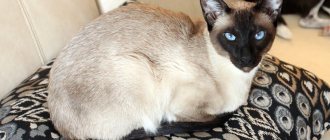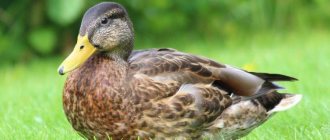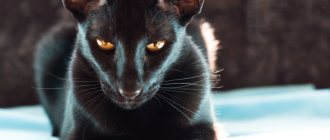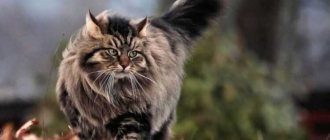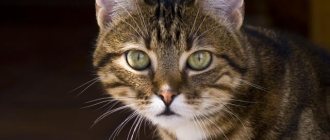The Siamese cat is a popular short-haired breed with a recognizable point color. Unique beauty is combined with sociability and intelligence. A good companion for those who value open expression of feelings and constant connection with their pet. These talkative cats will not let you get bored and will participate in all family activities.
| Breed | Siamese cat |
| Type | Siamese-oriental (eastern) group |
| Country of origin | Thailand |
| Coat | Shorthair |
| Lifespan | 15 – 25 years |
| Kitten price | 8000 – 35000 rubles |
History of the origin of the Siamese breed
The Siamese cat is one of the oldest and most famous cat breeds. Despite this, the origin of Siamese cats is still considered a mystery.
- The manuscript "Book Poems about Cats", dating back to 1350 - 1700, discovered in ancient Siam (modern Thailand), describes a pale cat with a dark coloration of the face, paws, ears and tail.
- According to legend, the Siamese were considered sacred. When a member of the royal family died, his soul was possessed by a Siamese cat, which then lived in the temple in luxury with monks and priests as servants. The theft and killing of a Siamese cat was punishable by death.
- Uncontrolled crossbreeding of Siamese in the 19th and 20th centuries led to cats no longer meeting the breed standard. Modern Siamese have become thinner and have acquired a characteristic triangular muzzle.
Subsequently, Siamese cats quickly became popular in different countries. This breed was first seen in Europe in 1871 at the London Cat Show. In 1879, a Siamese cat was given to the wife of the US President. The Siamese Cat Club was formed in 1901 in Great Britain, and the Cat Fanciers' Association (CFA) recognized the breed in 1906.
Related breeds:
- Oriental cat.
- The Balinese cat is a semi-longhaired Siamese cat.
- Burmanskaya.
- Thai is a restored Siamese breed according to the old type standard.
- The Himalayan is a long-haired breed developed by crossing Siamese and Persians.
Differences between Siamese and Thai breeds
Buying and training a Siamese kitten
It is advisable to buy a purebred kitten from a nursery. You should not buy a baby under three months old.
Before picking up a kitten from the cattery, you need to follow some instructions:
- It is necessary to carefully examine the cub: ears, tail, eyes, teeth.
- You should ask the breeder for documents and a vaccination certificate.
- It wouldn't hurt to look at the baby's parents.
To avoid mistakes in education, you need to study the character and psychological characteristics of the breed. Understand that humanizing cats does not increase mutual understanding, because... The pet's character consists of animal instincts and to demand human behavior from it is simply a crime. A break in character can lead to a cat becoming withdrawn and aggressive.
The small dimensions of the apartment are not suitable for active and playful cats. Needing companionship, Siamese will be aggressive, remaining alone in a room for long periods of time. Constant meowing and cooing (or even heartbreaking screams) will irritate older and nervous people.
People with a soft character will not be able to cope with the lordly manners of their pet. Siamese get along well with children. But small children may not be able to cope with their emotions and rudely disturb their peace. Then claws and teeth may respond.
The Balinese cat is a type of Siamese. This breed appeared due to constant mutations during the merger of the Siamese breed. The main difference from an ordinary Siamese cat is its soft and flexible character. Therefore, they are purchased by people who do not want anyone to disturb the calm flow of life.
The body structure of the Balinese cat is muscular, flexible and slender, as expected of the Siamese breed. The head is wedge-shaped. The eyes are almond-shaped and blue, but there is no squint. The wool has no undercoat, so the rules of care are very simple.
Interesting facts from the life of Siamese cats
Siamese cats are popular in many countries around the world. In America they occupy not the last place in the top ten. It is very rare that exhibitions are organized without Siamese beauties.
- Smart, beautiful and graceful animals decorate exhibitions with their presence. It was the Siamese cat named Mio that took an honorable prize place out of 524 participants. This largest exhibition of the 19th century took place in London. The winner, Mio, was awarded a gold medal and a silver service.
- One owner took advantage of the intelligence and intelligence of a Siamese cat. He taught his pet to steal money. For the purchased goods, the villain paid with banknotes sprinkled with valerian. The cat climbed through the window into the victim’s apartment and found money by smell. Neither the owner nor the cat were punished for their crime.
- These cats have the longest gestation periods. It lasts 65 days, others carry cubs for 50-55 days.
- Queen Elizabeth II received a Siamese kitten as a wedding gift.
- The beautiful unusual color of Siamese cats depends on the thickness of the skin - the thinner the skin, the darker the hair on the body. In countries with cold climates, the cat pattern becomes clearer and more pronounced.
Description of the Siamese breed
Let's look at the appearance and character of Siamese according to the breed standard.
Standard
Siamese cats are well balanced, boasting an athletic, flexible body and elegant, slender legs.
The breed standard for the modern Siamese cat assumes:
- Body: Elongated, tubular and muscular. A typical Siamese cat has a total height of 20-25 cm and a body length of 29-36 cm, with a body weight of 4-5 kg.
- Head: Straight profile with a strong chin and a pleasant, even bite. The head forms a perfect triangle from the tip of the nose to each tip of the ear. The neck is long. The eyes are almond-shaped, bright blue, and the ears are large, wide, located closer to the head.
- Limbs: The cat's hind legs are longer than her front legs, which adds to her athletic and graceful appearance. The paws are oval shaped and small. Thin tail.
- Coat: Short, shiny, fine coat without undercoat that lies close to the body.
Today, there are over 20 varieties of Siamese cat colors all over the world, and the most famous of them are:
- Seal point (brown or cream), with a cream-colored body and dark brown pigments on the nose and paws. It is believed that this was the original color of the breed when it was first exported from Siam (Thailand).
- Blue Point (blue) - the body is snow-white with a bluish tint, as well as a gray nose and paws.
- The Red Point is a white body with red (apricot) pigments on the nose and paws.
- The Caramel Point (light cream) is considered a hybrid due to a complex breeding process, with very light and pink pigments on the nose and paws.
- Chocolate point (black). The body is cream or milky in color, and the pigments on the points can range from chocolate to black.
- Cinnamon point (ivory). The body is ivory-colored, like a Chocolate Point, but the markings on the nose and paws are pinkish-brown.
Photos of colors
Seal Point
Blue Point
Red tabby point
Caramel point
Chocolate Point
Cinnamon Point
Kinds
The classic Eastern Oriental group of the Siamese breed includes the following varieties.
- The Siamese is a short-haired cat with a narrow wedge-shaped head, pointed ears and blue eyes. The body is thin, proportional, legs and tail are long. These cats are very beautiful and are one of the favorite breeds of many breeders. They have a combination of white and cream coats with dark brown points.
- Thai species - considered the standard of the original breed that existed in Thailand. They differ from the Siamese species in that all the lines and proportions of the body have rounded and smoother lines.
- Oriental appearance - the body has the same structure and proportions as that of the Siamese species, but with the difference that the color of cats is uniform gray or black, spots may sometimes be present, but this species does not have points in color. This species was introduced along with the Siamese, but did not excite breeders and was not so widespread.
- Mekong Bobtail - the color and structure resembles the Thai species, but the bobtail has a tail that looks like a stump, consisting of several vertebrae.
Modern breeding species of Siamese cats may vary in color characteristics.
Brown seal point - the overall body color of the cat is light cream, and the points have a dark chocolate shade of color.
Character of Siamese
Siamese are known for being one of the most intelligent and vocal cats in the world and will happily spend time with their owners. Siamese cats are affectionate with domestic cats, however, they can be demanding and suspicious of strangers. Many people say that their Siamese pets greet strangers at the door and go through some kind of approval process before visitors enter the house.
At the same time, Siamese cats are very active and love active games with toys. When it comes to training, they do not have any special exercise needs because Siamese cats are very active and playful in their own right.
They quickly get accustomed to the litter box and scratching post; the main thing is not to shout or force the cat to do anything. Siamese are quite proud and can become stubborn from such treatment. You can even toilet train them if you start training them when they are young.
You should not get a Siamese cat if you are often away from home. The pet will get bored and entertain itself in any of the available ways.
The stereotype about the evil character and vindictiveness of the Siamese, as a distinctive feature of the breed, originated in the USSR. The price of a purebred Siamese cat was high, so we usually received rejected kittens with squints, creases in the tail and abnormalities.
Raising a Siamese
As already mentioned, Siamese are smart and savvy. Therefore, accustoming them to a lifestyle that is convenient for you is not so difficult, but this must be done from an early age. The caregiver will have to be patient and find an approach to a pet with an independent character.
Sleeping area
In order to grow and get stronger, a small kitten needs a lot of sleep. The resting place must meet the needs of the animal:
- The main condition for a kitten to feel comfortable is warmth. Therefore, the place should be far from drafts, but it should not be located close to heating appliances in winter;
- cats love secluded places, so observe where the kitten most often likes to fall asleep (but not in the owner’s bed);
- cats, even when immersed in slumber, are constantly on the alert, so from their hiding place the animal must be able to observe the surrounding space.
A place to rest can be equipped in a wicker basket, lining it inside with a warm blanket or in a cardboard box, having previously covered it with soft fabric. In specialized stores you can purchase ready-made soft houses for cats.
You need to prepare a cozy and comfortable place for your baby.
Toilet training
A naturally clean Siamese can be quickly trained to relieve his natural needs in one, specially designated place. But for this you need to prepare a container, preferably plastic (it is easy to clean) and filler. The kitten may not like containers with bars, because from birth he has an inherent need to bury his waste products. If you don’t clean and wash the tray in time, the little neat guy will find another place for himself, and perhaps more than one.
By the way, about the place for the tray. It should be as comfortable as possible for the kitten. It is advisable to select a secluded place, closed from prying eyes, and the animal should have free access to it. As soon as you notice that your baby is looking for a place to relieve himself, immediately take him to the litter box and leave him there. After the kitten has successfully completed the task, be sure to praise him. And do this every time, developing a reflex in the animal. And positive emotions will only accelerate the habit.
Don't forget to regularly clean and disinfect not only the tray, but also the area where the cat's litter box is located.
If you teach a Siamese to order from an early age, there will be no problems.
Hygiene procedures
From an early age, teach your baby to hygiene procedures. But first, teach him not to be afraid of your touch. Stroke the animal, but do not make sudden movements. A pet that is accustomed to being groomed will not have the desire to scratch or bite you during treatment.
How to deal with bad habits
The wayward Siamese has a lot of bad habits that you have to overcome. But first you need to calm the animal down. In the first days of being in a new environment, he may behave restlessly and meow constantly. This is understandable, because he was separated from his mother, and the baby does not yet understand where he ended up. Your task is to remind your pet as often as possible that he is in caring hands. To do this, pet your baby more often and speak kind words to him.
If your cat wakes you up in the morning with frantic screams demanding food, then try to wean him off this in the following way. Do morning feeding not when you get out of bed, but before leaving for work. This will require patience and time. But very soon the Siamese will become accustomed to the new regime, and he will sleep peacefully in the morning.
A Siamese may also complain due to lack of attention to his person. Therefore, think about whether you are paying enough attention to your pet. After all, for its active energy there must be a way out. Find free time to play with your cat, this will only strengthen your bond.
If you pay little attention to your pet, he begins to entertain himself
Sharpening the claws of Siamese, just like other cats, is a physiological need. Therefore, at first, try to cover upholstered furniture with covers and raise the curtains higher. Carefully observe where your tomboy most often performs this procedure. This is where you will install the scratching post. You can buy it at a pet store or build it yourself by attaching a plastic pipe to the base and wrapping it with thick rope.
In addition to instilling useful skills in your child, you yourself should serve as a role model. Do not throw clothes anywhere, put shoes on shelves, and do not leave leftover food on the table. If there is no temptation, the Siamese will not do any mischief. And most importantly, training should always end with encouragement. And your screams or spanks will not end well.
Health
With proper care and nutrition, the average lifespan of Siamese cats is 15-25 years.
They may also have problems with progressive retinal atrophy, which can lead to poor vision and even blindness. Glaucoma and strabismus are also common among eye diseases.
This breed is more prone to lung infections than others. The most common condition is asthma, which causes inflammation and narrowing of the lungs' airways.
These cats are known to have very sensitive stomachs. In addition, Siamese cats may have problems with the heart, kidneys and liver.
Advantages and disadvantages of the breed
The positive characteristics of Siamese cats include:
- Magnificent mind.
- Excellent trainability.
- Loyal to their master.
- They have an attractive appearance. This can be seen by looking at a photo of a Siamese cat.
- They get along well with the smallest members of the family.
- Practically not subject to shedding.
- Playful and cheerful.
Pets also have disadvantages:
- Siamese are very touchy and can remember bad things for a long time.
- They are independent and have willful characteristics.
- Demanding about cleanliness.
- They do not tolerate cold well.
- They have a fairly loud voice.
- They are jealous and cannot tolerate cohabitation with other animals.
Breed card
| Characteristics of a cat | Notes | |
| General information | An ancient cat breed known for its pointing color, playfulness and ringing voice. Extroverts by nature | Modern Siamese are the result of restoring the standard of an ancient breed. And those yard cats, which in Russia are usually mistaken for Siamese, are representatives of the Thai breed |
| Character | Siamese require their owner's attention constantly. They have an affectionate nature and are quick-witted, but can be stubborn | Purchase various toys in advance so that your pet always has something to occupy himself with. The best solution would be to purchase a play set for cats |
| Appearance | A medium-sized cat with a slender, athletic body, an elongated wedge-shaped head, large ears, and blue or blue eyes. Kittens are born completely white. Points (areas of dark fur) develop as the dog matures, with the sides usually being the last to darken. The final color is formed by 2 years of age. | Strabismus and creases in the tail are a defect in the breed. If you are offered a kitten with green or yellow eyes, then this is not a Siamese, but perhaps an Oriental. |
| Behavior at home | Active breed. They love to climb and play. Very talkative, especially cats during mating season | Siamese are sexually horny cats, so their puberty begins earlier than other breeds. You can castrate your pet at the age of 4-5 months. |
| Care | Minimal maintenance as there is no undercoat. Combing once a week. A scratching post is required | |
| Health problems | Among the congenital defects there is strabismus. Modern Siamese have problems with tail kinks and respiratory problems | Food allergies to cow's milk are common |
Pregnancy and childbirth
Cats typically reach puberty at 8 months of age. But Siamese cats, which belong to the oriental type, enter this period earlier - at 4 - 5 months. The onset of sexual activity may be influenced by the time of birth of the animal. A woman born in the spring may demand a cat in the fall, and a woman born a little later will most likely begin to come into heat in the spring of next year. The ability to reproduce begins only at 10 months of age and continues until 8 years.
The average gestation period for Siamese cats is 65 days. Lambing that occurs before 60 days is considered premature. Kittens born at this time are considered non-viable. If labor does not begin on day 68, we can talk about post-term kittens, in which case you need to seek help from a veterinarian.
If the date of the tailed couple was successful, then in the first month the first changes in the appearance and behavior of the cat will become visible. At this time, there is a slight increase in weight. There may be loss of appetite and slight vomiting. After day 35, the cat’s tummy becomes rounded, the nipples turn pink and enlarge. There is an appetite and a desire to sleep longer. During this period, the cat’s life is almost no different from before, but too active games should be prohibited, although dosed activity is necessary. In the later stages, a pear-shaped tummy appears, and by placing your hand on it you can feel the kittens moving. 2 weeks before birth, the movements of the kittens in the womb are clearly visible when the tailed mother lies on her side. During this period, the animal's activity is significantly reduced. It is best to provide your cat with a cozy place to rest and not disturb her unnecessarily.
During pregnancy, the cat should feel comfortable
A week before the start of labor, take your pet to the veterinarian and agree with him so that qualified assistance is immediately provided in case of complications.
The behavior of the animal speaks eloquently about the approach of childbirth. The cat begins to actively look for a place to lamb. The loop enlarges greatly, and clear or light pink discharge appears. The tailed mother may completely refuse to eat. The animal becomes especially affectionate and demands attention to itself.
For lambing you need to prepare a special place, or better yet several. Any cardboard box with low sides will do so that the cat does not touch her stomach. The box is lined with a warm mattress or a blanket folded several times, over which a clean sheet (disposable or cotton) is laid. The nest is placed in a secluded place where households or pets do not look.
A naturally physically developed and healthy cat will cope with childbirth on its own. But your presence nearby is simply necessary, especially if the cat gives birth for the first time. Just be nearby so that the furry woman in labor feels your presence and support.
Just in case, prepare the necessary tools to assist the tailed woman in labor and her offspring. You will need:
- sterile gloves;
- sterile scissors with rounded tips;
- thread for tying the umbilical cord (catgut);
- clean diapers and towels for drying kittens;
- eye pipette for suctioning mucus from the respiratory tract of kittens;
- iodine;
- peroxide;
- cotton buds.
Keep your phone number and veterinarian number nearby in case you urgently need advice or help.
Once the kittens are born, you will need to monitor the temperature inside the nest. To do this, place a thermometer at the bottom of the box. During the first 3 days of life, kittens need to be warm, so keep the temperature around 29°C. This can be easily done by placing a heating pad under the mattress. Then, every week, reduce the temperature by 3°C, gradually bringing it to 21°C.
Newborn Siamese kittens - video
Care
They are incredibly clean and don't shed much, so caring for them is not particularly difficult.
Wool
Even though Siamese cats have short hair, they need to be brushed weekly. Many fans of this breed recommend small rubber brushes. You need to comb in the direction of hair growth.
Most Siamese cats are very clean and clean themselves well, so you can bathe them no more than 2 times a year. However, when they are very dirty or have gotten into something sticky, they may need a little help.
Advice! Place a rubber mat in the sink or bathtub to prevent your cat from slipping.
Nutrition
In addition to basic veterinary care such as vaccination compliance and regular checkups, proper nutrition is important. Providing a proper diet can help prevent health problems in your pet later in life.
Advice! Don't forget to change the water and wash the bowls daily!
There are two options for feeding your pet: natural food and industrial food.
Natural nutrition
- Basic nutrition – animal proteins:
- Lean meats (chicken, rabbit, lean beef and turkey).
- Sea fish and seafood (tuna, cod, shrimp) - as a source of healthy fats and taurine.
- Eggs (preferably quail) – no more than once a week.
- Beef liver and offal - tripe, udder, lips, chicken necks.
- Carbohydrates and fats
:- Fermented milk products - cottage cheese, ryazhenka kefir, yogurt without additives.
- Vegetables and greens - zucchini, carrots, spinach, pumpkin, broccoli, peas, beets.
- Porridge – buckwheat, millet, oatmeal, rice.
- Linseed oil.
- Vitamins – additional vitamin complexes are required for natural nutrition. Main additives: taurine, tetravit, calcium and yeast as a source of B vitamins.
Important! Red meat and liver can darken light fur, so you should not make such foods the main food for show cats.
Industrial feed
The basic rule is not to feed your pet economy-class food. The ideal option would be brands from the super-premium and holistic categories. We have previously compiled ratings for dry and wet cat food.
Recommended brands:
- Orijien Fit & Trim.
- Acana Light & Breed.
- Go Natural.
- Eukanuba Sterilized.
- Bosch Sanabelle.
- Royal Canin “Sterilized 37”.
Sometimes cats are allergic to grains, cow's milk and poultry. In such cases, it is necessary to switch to grain-free lines such as Natural & Delicious, which are free of rice, corn and chicken.
Adult pets with certain diseases (diabetes, urolithiasis, renal failure and heart pathologies) are transferred to specialized veterinary nutrition. A good line of medicinal foods is represented by the Hill's Prescription Diet brand.
Vitamin-mineral complexes are not needed, because manufacturers necessarily include all the compounds necessary for the body in the feed.
Caring for ears, eyes, teeth and claws
- If possible, you should brush your cat's teeth 2 times a week. We revealed all the nuances of this simple procedure in this article.
- The almond shape of the eyes allows pus and tear fluid to accumulate in the corners, so be sure to wipe your eyes with a damp cotton pad as needed.
- Ears should be wiped with a barely damp cotton pad once a week. If you notice black spots, crusts and an unpleasant odor, take your pet to the doctor. The most common cause of such symptoms is ear mites, which are easily eliminated in the initial stages. If left untreated, it can lead to hearing loss.
A visit to the veterinarian every year is mandatory for keeping a Siamese cat. Examinations provide an opportunity to early detect health problems, including those that may change your cat's care needs. For example, viral diseases, eating disorders, heart and kidney problems.
The frequency of visits to the veterinarian depends on the age of the pet:
- kitten 1-4 months – monthly visits;
- 4 months to 7 years – 1-2 times a year;
- 7-10 years – twice a year;
- over 10 years old - visit every 3 months or more often, as age-related health problems only increase.
Walking your pet
Siamese cats are ideal pets for both apartments and country houses. They are perfectly adapted to travel and trips, because the main thing for these creatures is the presence of their beloved owner nearby. Cats are good travel companions when they are happy. Your job is to figure out how to make their journey comfortable. Bring your favorite bed, litter box, toys, food and litter box.
They can also be easily trained to walk outside in a harness or in a walking carrier.
Cat breeds with blue eyes
Among the breeds of blue-eyed cats, there are the most famous ones, which are popular with both professional breeders and lovers of furry friends.
Siamese cat
The Siamese cat is one of the oldest and most famous representatives of the cat family. It originated from Thailand and quickly gained popularity around the world. Externally, Siamese are very similar to Thai and Oriental cats, but one of the most striking distinguishing features is their bright blue eyes. Siamese also have a long and slender body with pronounced muscles, large triangular ears and a flexible, thin tail. The breed has dark spots on its limbs and face, and its coat color ranges from cream to chocolate.
The Siamese cat is an animal whose appearance creates a general impression of slenderness, lightness and swiftness.
Siamese are proud and self-confident cats that demand attention. They have a fickle and explosive nature and can be either capricious and nervous or loyal and friendly. Despite the fact that Siamese cats become attached to their owners, they have no authority, and therefore their trust is very easy to lose. The Siamese does not like affection, but will happily share active games and walks in the fresh air. There will never be a dull moment with a Siamese cat.
Sacred Burma
The state of Myanmar (formerly Burma) is the birthplace of the Burmese cat. In ancient times, the breed was considered sacred and lived in temples. At the beginning of the 20th century, a millionaire from America imported the Burmese cat to Europe, after which it became widespread. Getting to know Burma is not difficult. This is a semi-longhaired color-point cat with white “gloves” on her paws. The Burmese has a medium-sized body with short legs and a bushy tail, round cheeks, and bright blue eyes.
Where Burmese cats walk, there is no place for negative emotions - only goodness and positivity
Burmese cats have wonderful personalities. They are affectionate, inquisitive and loyal. The breed is very attached to its owner and gets along well not only with all family members, but also with other pets in the house. Burma loves to be the center of attention and share a wide variety of activities. Calmness and balance do not allow her to cause damage to her home environment or enter into conflicts with other animals. Burmese cats gladly accept affection and are always warm and friendly towards new faces.
Khao-mani
Since the times of ancient Siam, kao-mani was considered an indicator of the wealth of the family in which it lived. And now this snow-white beauty is highly appreciated by both ordinary cat lovers and professional breeders. The Kao Mani is an example of a breed that can have both blue and multi-colored eyes. The latter phenomenon is called heterochromia, it appears when the eyes are located on areas of the coat that differ in color. In addition to beautiful eye color, Kao Mani has short snow-white fur, a wide forehead, large ears and a strong tail.
The grey-blue shiny eyes of these cats fascinate with their beauty; it is not for nothing that the name of the breed is translated as “diamond eye”
People believe that kao mani with different colored eyes can bring good luck.
The Kao Mani is an easy-going and friendly breed that requires a lot of attention. She quickly gets used to her owner and cannot stand being alone. Kao-mani is very vulnerable and can be offended for a long time, and therefore you should not have such a pet at home if you do not have the opportunity to pay attention to it every day. A cat of this breed easily gets along with people and other pets in the house. Very playful and intelligent, amenable to training with simple commands and has a developed hunting instinct. Possessing this quality, the kao-mani will immediately rush to the defense of its owner and once again prove its loyalty to him.
Ojos Azules
Ojos Azules is a unique cat breed with blue almond-shaped eyes and a wide variety of coat colors. The differences in the exterior of this breed from others are not very pronounced, and therefore there are many variations in the appearance of the Ojos Azules. Nevertheless, there are general standards: an elegant and strong body, giving the appearance flexibility and fit, high ears, a tail proportional to the body.
The main advantage of Ojus Azules is its bright blue almond-shaped eyes.
Ochus Azlues is suitable for people who prefer to spend their free time in a quiet home environment, because this breed is extremely peaceful and calm. Despite the attachment to the owner, the pet will not depend on his attention and will calmly endure some time of loneliness. Ojus azules feels comfortable in silence, away from large companies. So don’t be surprised if your cat goes missing if noisy guests come to your house. Despite the love of calm, a representative of this breed will happily share active games and outdoor activities. Ochus azules easily finds a common language with other pets and lives under the same roof for many years without any conflicts.
Important! Under no circumstances should representatives of this breed be crossed with each other, since the altered blue eye color gene affects the health and vitality of the kittens.
Himalayan cat
The Himalayan cat is the result of crossing the Siamese and Persian cats. From the Siamese she inherited blue eyes and an unusual color with dark spots on her face, paws and tail, and from her Persian ancestors she got a fluffy and soft fur coat. The Himalayan cat gives the impression of a strong and strong animal due to its powerful body, muscular legs and pronounced chin contour. The luxurious coat of this breed requires constant care and careful daily brushing.
The Himalayan cat has the fur of a Persian cat, the flexible body of a Siamese, blue eyes and an independent disposition.
This breed is very affectionate and playful. She loves the attention of her owner, happily settles on his lap and loves when her soft fur is combed and stroked. Despite its attachment to its family, the Himalayan cat can easily endure loneliness when they are not at home. Representatives of the breed skillfully maintain a balance between love for humans and their independence. They are unobtrusive and never achieve anything with persistent meowing. Sometimes cats have short bursts of energy, during which they actively participate in games and ventures, but mostly they prefer to spend time in lazy contemplation of their surroundings. The Himalayan cat gets along well with all family members and other pets in the house. This breed makes an excellent companion for older adults.
Oriental cat
The white oriental cat is related to the Siamese, but unlike them, it has a solid white coat, which can be either long-haired or short-haired. The graceful Oriental is both graceful and muscular, her long body with an elongated neck is crowned by a triangular head with large ears. Almond-shaped eyes can both be blue or multi-colored. The white oriental cat is one of the most popular breeds that fascinates cat lovers with its aristocratic appearance.
A long graceful body, a wedge-shaped head, large ears - a white oriental cat can be seen from afar
This graceful beauty considers herself the center of the universe and loves attention to herself, and therefore begins to suffer and be offended if she does not receive it for a long time or is alone. She is very talkative: she will definitely express her dissatisfaction or joy by meowing. The breed loves to communicate with people and other pets, play and share various activities, and is always ready to stand up for itself and fight back against the offender. The white oriental cat is very energetic and active, she loves to explore all the secret corners of the house and climb even to heights that seemed unattainable. Therefore, if you want to have a representative of this breed at home, it is better to take care of indoor plants, which will definitely be disturbed by the new inhabitant at a convenient moment.
Turkish Angora
The Turkish Angora is one of the oldest cat breeds. It appeared in Turkey and in ancient times was a very expensive and valuable gift, and therefore its owners were monarchs, sultans and other high-ranking officials. And now the Turkish Angora delights with its beautiful snow-white coat and pleases with its pleasant disposition. Representatives of this breed have a muscular body, a bushy tail and high-set, tufted ears. Almond-shaped eyes can be multi-colored.
Outwardly, this breed of cat looks stern and unapproachable, but in fact the Turkish Angora is very affectionate and friendly.
This breed is very brave, determined and persistent. She always achieves her goals, be it a toy put away on the top shelf of a closet, or a tasty treat. He loves to play and generally does not sit still, sometimes even forcing him to chase after himself. The Turkish Angora is friendly, it gets along well with pets and households, it becomes very attached to its owner, most often singling out one of the large family. This cat is soft, affectionate and friendly. She does not like loneliness and always needs company and active pastime. Despite its cheerful and gentle disposition, the Turkish Angora can stand up for itself and will never allow itself to be offended.
Blue British cat
The British cat is one of the most popular breeds not only in the UK, but throughout the world. It is characterized by a strong body with strong limbs, a round muzzle and a short tail. The British cat's coat is short, shiny and thick. Among lovers of the breed, special attention is paid to the blue coat color, which even received its own name - British Blue. But these cats can have fur of a wide variety of shades, of which there are currently more than a dozen. There are also several variations in eye color: from bright orange to blue, depending on the color.
Color-point cats have blue eyes, and rare chinchilla cats have lavender, blue or emerald green eyes
This breed has a sense of self-esteem, it is calm, intelligent, intelligent and restrained in emotions. Very clean and does not require complex care. British cats are very affectionate, they quickly become attached to their owners, without singling out one person, as other breeds often do. Thanks to his independence, the British spend time quietly alone, but always look forward to the return of his family to chat or just sit next to him. This trait allows busy and hard-working people to own a representative of this breed. But despite the ability to easily tolerate loneliness, the pet needs affection and care, and therefore it is important to pay enough attention to your pet in his free time.
Scottish fold cat
The appearance of this interesting breed is caused by a natural genetic mutation. It all started with an ordinary Scottish cat, Susie, who had slightly curved ears. Her kittens were subsequently crossed with the British Shorthair breed, resulting in these unusual creatures, which are now called Scottish Fold cats. The body of the breed is strong with short but soft limbs, the tail is proportional to the body. The thick, plush coat comes in a variety of colors and can be either long or medium. Eye color ranges from hazel to blue.
The Scottish Fold cat is a sweet creature with a wonderful character, capable of quickly adapting to a new environment and people.
Scottish Fold cats are very loyal, kind and sweet animals that choose one person from all family members and follow on his heels. But despite their devotion, they cannot be called intrusive and demanding: most often it is enough for them to simply be near their owner, and not to take all his attention. Fold-eared Scots treat large and noisy companies calmly and quickly adapt to a new environment. The breed does not suffer from hyperactivity, so there is no need to worry that in your absence at home some valuable object will break or a flower pot will tip over due to the efforts of your furry friend. These cats love to meditate on their backs, stretching out their paws, which once again proves the calmness and tranquility of this breed. You should not leave your Scottish pet alone at home for a long time: he may get bored. For example, another good-natured pet can correct this situation.
Javanese
Another result of the work of breeders is the Javanese, which was obtained by crossing short-haired colored breeds with the Balinese cat. The homeland of this unusual breed is North America. Geneticists wanted to diversify the Balinese breed with other colors. The result is an animal for which several types of colors are allowed: from cream to blue. The Javanese cat has a long body, a fluffy tail that stands out against the background of the fur all over the body, and an elongated muzzle with large ears. Almond-shaped eyes have a rich blue color.
Thanks to the elongated muzzle and large ears, we can confidently say that Orientals are the rightful ancestors of the Javanese
The breed is playful, curious and restless. As they grow older, their activity decreases slightly, but the Javanese still remains a lover of outdoor games and exploring the contents of even the tallest drawers and shelves. This animal needs space for action, and therefore it is not suitable for those people who like to maintain perfect order in the house . Javanese will happily throw objects around, carry things throughout the apartment and bring various trinkets to the owner. Javanese does not like loneliness, he gets very bored in the absence of people, and upon their return he follows on their heels everywhere and does not give way. The Javanese cat shows its lively and strong character in any conflicts or situations where it needs something: it will stand up for itself without delay and will definitely achieve what it wants.
How to choose a kitten
When choosing a Siamese kitten, the most important things are its health and pedigree. Therefore, it is imperative to see the kittens’ parents and find out about their general health. Any mention of heart or liver problems in either parent should be noted as these can be passed on to the kittens.
You should also look at the place where the kittens are kept to make sure that they are free of dirt, fleas and ticks. Siamese kittens are social and quite dependent on their parents.
Therefore, kittens should not be weaned from their mother before 12 weeks of age, otherwise they may develop severe anxiety disorders.
You may notice that the kittens are either creamy white or lighter in color than expected. This is fine. The face, paws and tail darken at about 4 weeks of age and continue to darken until the kittens are 1-2 years old. The size of the points directly depends on the temperature of the habitat. The lower the temperature, the more the coat darkens.
That's why newborn kittens, warm from their mother's womb, are white everywhere. Then, as they grow at normal temperatures, the hottest area of their body, around the belly and back area, remains pale while the limbs gradually become darker. And in an adult cat, the general body temperature begins to drop somewhat, and over time the fur darkens more and more.
As for the cost of a kitten , this indicator depends on the following factors: age, pedigree, health status, availability of vaccinations, travel box, toys, etc. Also of great importance is the owner's guarantee that her parents do not suffer from any serious diseases that could be inherited by the kitten.
- The price of a pet-class kitten (pet) is 3000-8000 rubles.
- Breeding class (breeding) – 10,000-15,000 rubles.
- Show class (show kittens) – the price depends on the nursery, from 30,000 rubles and above.
Features of the blue eye color gene
At birth, all kittens are born blue-eyed, which can be explained by a lack of melanin, the substance responsible for color pigment. As growth and development progress, the iris acquires the shade the baby inherited from the parents, usually taking from 4 to 12 weeks. But sometimes a kitten retains blue eyes for the rest of its life for several reasons:
- presence of a dominant white gene. White cats most often have blue eyes. The white gene, designated by the letter W, can cause deafness in a cat, as it negatively affects the formation of cells that are responsible for hearing acuity. But this may not happen to every white-haired pet;
- albinism. Blue-eyed albino cats are a fairly rare but existing phenomenon. Siamese cats also have the albinism gene, which is why their fur is partly bleached and their eyes are blue. Lightening occurs due to the thermal sensitivity of the wool in some places. Due to temperature changes, the fur changes color and acquires a Siamese color;
- spotting. The tortoiseshell color often has white in its color scheme. If the white spot is near the eyes, then they will also acquire the W gene and become blue;
- involvement in blue-eyed cat breeds. For example, the Ojos Azules breed has this name due to the presence of the blue color of the iris, and the cat itself can have fur of various shades. Ojos Azules do not have visual or hearing impairments.
Blue eyes in cats can occur for many reasons.
Albino cats differ from cats with a snow-white coat by the absence of the color gene and are very rare: one albino in ten thousand animals.
The layer of the eyeball called the tapetum, which reflects light at dusk, appears yellow or green in photographs in normal cats, and red in photographs of albino cats.
There are very few breeds of blue-eyed cats, and those that exist are rated very highly by cat lovers around the world.
Breeding
If you decide to start breeding a Siamese cat, the first step is to find a healthy male. Of course, the best way to do this is to contact the owner of a nursery near where you live. A Siamese cat owner with a good pedigree will be happy to help you in this matter, as he knows how important it is to keep the blood lines pure and reduce the risk of any hereditary problems.
When choosing a breeding cat for your Siamese breed, consider the following factors:
- Is this the first time your female will be mating? If the answer to this question is yes, then you should think about having an experienced male.
- Have you had all the necessary tests? Before you take your cat for mating, you should arrange a visit to the veterinarian to confirm the absence of hereditary and viral diseases.
- What are you going to do with the kittens? When choosing a breeding cat, you need to make sure that you can sell the kittens in the future.
Pregnancy in Siamese cats is slightly shorter than other breeds - 58-65 days. On average, a Siamese cat gives birth to 4 to 6 kittens. The colors of kittens can be predicted in advance by knowing the recessive and dominant genes for coat colors in both partners.
Siamese catteries in Russia
The Siamese breed is one of the most numerous, so finding a nursery is not difficult at all:
- "Orientville" - Moscow.
- "Siaorimania" - Moscow.
- "Jubatus" - Novocheboksarsk.
- "JUNGLE" - Moscow.
- "Eastward" - Moscow region.
- "EkstaSia" - Yekaterinburg.
Taking the kitten home
If you have already found a suitable cat with kittens, you should take into account that premature deprivation of babies from maternal care has a bad effect on their psychological state. So, in this regard, we can strongly advise you not to adopt a kitten until it reaches one and a half months old. The best thing to do would be to wait even longer.
Fluffy babies of any breed, of course, do not easily tolerate a change in their usual environment. So, if a kitten in a new place immediately climbs into some distant secluded corner, where no one can get it, then this is quite normal.
And then you should not try to call it out, but you should place bowls with drinking water and food nearby, as well as cat litter.
Try not to make loud and sharp sounds at first, so that the baby does not get scared and realizes that the environment around him is completely safe with non-hostile inhabitants. After some time, usually an hour or two, the kitten’s curiosity and hunger will prevail, and it will leave its shelter.
Interesting facts about the Siamese cat
- The color of their coat is determined not only by heredity. This breed has a special modifier gene that prevents the development of pigment in the fur, which leads to albinism.
- Siamese are considered one of the oldest cat breeds in the world.
- Legends say that in ancient times the first Siamese cats were tasked with guarding the royal cup. They looked at him with such intensity that their eyes crossed. For added security, the cats wrapped their tails around the cup, causing them to become permanently bent.
- Siamese cats have appeared in many Hollywood films.
Overall, this is the most affectionate cat breed you will find. She is very smart, obedient and friendly, and also loves and values human communication so much that she is even called a cat-dog.
Nutrition
Fluffy animals can eat anything that is edible; their stomachs are adapted to everything.
But still, it would be better to feed your pet dry food.
They contain everything necessary that the animal’s body requires.
How much food to give is determined individually.
But, there are rules for all types of Siamese:
- Up to six months you need to feed four times;
- Up to one and a half years three times;
- Then feed twice.
This is all you need to know about the nutrition of fluffy Siamese cats. But if this is not enough, you can seek the help of a specialist.

